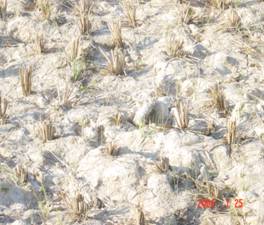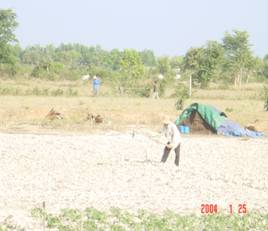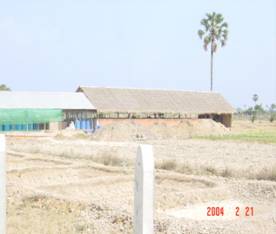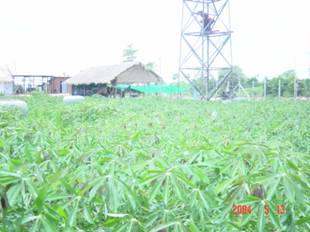Effect of water spinach and fresh cassava leaves on intake, digestibility and N retention for growing pigs
Chhay Ty
University of Tropical Agriculture-Cambodia (UTA-Cambodia)
Progress Report for MEKARN Fund
Starting date: 01 January 2004
Introduction
In order to develop pig production systems for poor farmers in Cambodia, it is important that the feed resources to be used can be grown by the farmer, as he / she usually has not the cash resources to buy from feed suppliers. Energy-rich feeds, derived from rice and cassava (roots) are widely available. The limiting factor is the source of protein as dried fish are only available at low cost in a few months of the year (from November to February) and although soya beans are grown, there is no processing factory for producing the soya bean meal. Thus in UTA efforts have been concentrated in developing systems using protein-rich forages which can be grown by the farmer. As the energy-rich feeds such as cassava root and broken rice, have negligible levels of fibre, this facilitates the use of the protein-rich forages, which are also rich in fibre. The possibility of reducing the protein in these diets to levels of less than 10% in the DM for growing pigs (Preston 1995; Perez 1997), as they have a more balanced array of amino acids when most of the protein comes from leaves, also facilitates this approach. Managing the cassava plant as semi-perennial forage with repeated harvesting at 2-month intervals, and high levels of organic manure, can give annual protein yields of 3 to 4 tonnes/ha (Preston 2001).
Nutritional experiments with pigs using cassava leaves have concentrated on ensiling the cassava leaves (Ly et al 2001), as this is a safe way of reducing the concentration of the precursors of HCN, which is the toxic element in fresh cassava leaves. Sun drying is even more effective than ensiling as a means of reducing the risk from HCN toxicity (Oke 1994); however, this is almost impossible to do in the rainy season and is also time consuming. Ensiling the leaves can be done all-year round but requires infrastructure and is also a laborious procedure. If cassava leaves could be fed fresh to pigs this would simplify the management considerably.
The other protein-rich forage that has recently received attention for pig feeding is water spinach (Ipomoea aquatica). It does not appear to contain anti-nutritional compounds and has been used successfully for growing pigs as the only source of supplementary protein in a diet based on broken rice (Ly 2002). In this research there was a significant response in growth rate and feed conversion to supplementary DL-methionine. Prak Kea et al (2003) reported a linear increase in growth rates in pigs fed water spinach, palm oil and broken rice when up to 6% fish meal replaced equivalent amounts of water spinach, which they attributed to an improved amino acid balance, especially in terms of the sulphur-rich amino acids.
This research proposal aims to test if offering a mixture of water spinach and fresh cassava leaves will be better than either forage fed alone for growing pigs
Experiment 1: Effect of water spinach and fresh cassava leaves
on digestibility and N retention in growing pigs
Animals, treatments and design:
Three crossbred pigs (Large White x Local) of 15 kg will be
housed in bamboo cages for collection of feed refusals, faeces and
urine. The experimental period consists of 12 days, seven days for
adaptation and 5 days for collection of feed refusals, faeces and
urine. Urine is collected in buckets with 10ml of solution
sulphuric acid (10%sulphuric acid concentrate + 90% distilled
water). Faeces are collected twice daily and stored at -18ºC and at
the end of each period sup-samples are mixed together and ground
with a coffee grinder. A sub-sample will be collected to analyse
for DM, N and ash according to AOAC (1990) methods. Feed refusals
are collected every day and will be analysed as for faeces.
The three treatments in a 3*3 Latin square arrangements are:
- Fresh cassava leaves
- Fresh water spinach
- Fresh water spinach + fresh cassava leaves (65:35 fresh basis)
The leaves are chopped into small pieces before feeding. The
leaves of the cassava are wilted for 24 hours before feeding but
the water spinach is fed immediately after harvesting.
The broken rice is restricted to 2 kg DM per 100 kg live weight.
The leaves are fed ad libitum. DL-methionine is added to all diets
at 0.3% (in DM) level in view of earlier results showing advantages
of supplementing a diet of broken rice and water spinach with this
amino acid (Ly 2002).
The data are analysed using the general linear model option in the ANOVA software of Minitab (version 13.31). Sources of variation are: pigs, periods, treatments and error.
Experiment 2: Effect of water spinach and fresh cassava leaves on growth performance
Eighteen crossbred castrated male pigs (15-20 kg) in individual
pens are blocked for live weight and allocated to 3 treatments.
Feeds and feeding system are the same as in experiment
1.
Feeds offered and refused are weighed daily and once per week
samples of feed offered and refused are taken for analysis. The
pigs are weighed every 14 days over the experimental period of 150
days. Growth rates are calculated from the linear regression of
live weight on days in the experiment. Samples of feed offered and
refused are collected daily and sub-samples stored at -18 C. These
are pooled on weekly basis and analysed for DM and N. The method
for N is that of AOAC (1990). DM is
determined by microwave radiation Undersander et al
(1993).
The data are analysed using the GLM option in the ANOVA of the Minitab
software (version 13.31) . Sources of variation are;
treatments, blocks, treatments*blocks and
error.
Preliminary results
Planting of cassava
UTA Cambodia established the new experimental (CelAgrid) in a new area in Kandal village, Rolous commune, Kandal steung district, Kandal province in August 2003. Until now, during the first 10 months, emphasis has been on preparing accommodation for staff, animal pens, office, laboratory, classroom and the improvement of the soil. The land at the centre was previously in monoculture rice for which the farmers burn the rice straw after they harvested the rice, they use only chemical fertilizer and cultivate the rice only one time per year (Photo 1). As a result the first priority is to improve soil fertility by using animal manure and biodigester effluent. The practice is also a way of demonstrating to farmers around the station of the disadvantage of using only chemical fertilizer.
Until now, efforts have been concentrated on planting the cassava in our station and only now is it starting to growth well. We plan to carry out the main experiments in August and later on.
Animal trial
The pig housing is completed (Photo 2). But because of the poor soil and drought in our station, we are late in starting the animal trial. Just now in May it began to rain and now the cassava starts to growth well (Photo 3) The animal trial will begin in August 2004.
|
|
|
|
Photo 1: The poor soil in CelAgrid station |
|
|
|
|
|
Photo 2: The completed pig pen for growth |
Photo 3: The cassava being grown for the |
References
AOAC 1990 Official Methods of Analysis. Association of Official Analytical Chemists. 15th edition (K Helrick editor). Arlington pp 1230
Ly J and Rodríguez Lylian 2001 Studies on the nutritive value of ensiled cassava leaves for pigs in Cambodia. http://www.mekarn.org/prockk/ly.htm
Ly J 2002 The effect of methionine on digestion indices and N balance of young Mong Cai pigs fed high levels of ensiled cassava leaves. Livestock Research for Rural Development. (14) 2: http://www.cikpav.org.co/lrrd/lrrd14/6/Ly146.htm
Oke O L 1994 Eliminating cyanogens from cassava through processing: Technology and tradition. In: Acta Horticulturea Cassava Safety 375. Proc. Int. Workshop in Nigeria. pp. 163-174
Perez Rena 1997 Feeding pigs in the tropics. Animal Production and Health Paper. No 132 FAO, Rome http://www.fao.org/docrep/003/w3647e/w3647e00.htm
Prak Kea, Preston T R and Ly J 2003 Effect of level of fish meal on growth and feed conversion of pigs fed a basal diet of water spinach supplemented with palm oil and broken rice. MSc thesis, MEKARN-SLU. http://www.mekarn.org/MSc/theses03/keaexp2apr25.htm
Preston T R 1995 Tropical animal feeding: A manual for research workers. Animal Production and Health Paper. No 126, FAO, Rome http://www.fao.org/docrep/003/v9327e/v9327e00.htm
Undersander D, Mertens D R and Theix N 1993 Forage analysis procedures. National Forage Testing Association. Omaha pp 154



